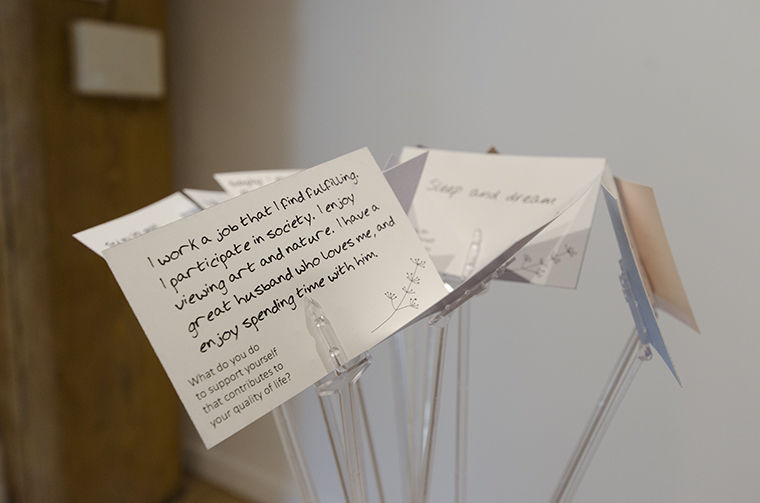Breast cancer exhibit wants you to ‘Take Care’
Words participants use to describe the healthcare system are displayed in the “Take Care” exhibit at the Weinberg/Newton Art Gallery, 300 W. Superior St.
September 18, 2017
Inside a gallery, a large installation hangs as a tribute to a mother and hospice worker fighting for quality healthcare.
Known for its exhibitions and partnerships with nonprofit organizations, the Weinberg/Newton Art Gallery, 300 W. Superior St., has worked with organizations such as the American Civil Liberties Union of Illinois and the Illinois Council Against Gun Violence to spotlight social justice issues. Running alongside the exhibition is a series of events and programs that highlight the organization’s mission.
This year, the gallery is spotlighting breast cancer patients’ battle for quality healthcare coverage with its “Take Care” exhibit, a joint project of the Metropolitan Chicago Breast Cancer Task Force—a nonprofit organization dedicated to fighting against breast cancer care inequalities. Running from Sept. 15 until Jan. 10, 2018, the exhibit showcases four artists’ paintings, sculptures and installations. The Task Force was mainly interested in getting the Chicago community to know who they are, what they do and to understand that the issue of access to quality healthcare.
“I was interested in expanding our notions of caretaking; it is not necessarily a doctor in a white suit or a nurse,” said Kasia Houlihan, the co-director of the Weinberg/Newton Gallery and the gallery’s curator. “There are networks of support when our health is in need of attention.”
The work on display illustrates the ideas of communities and support networks, part of the Breast Cancer Task Force’s mission.
A battle with two tumors spurred artist Indira Allegra’s work, which illustrates fear, cancer and courage using elements of color, sound and heat that contribute to an immersive experience, she said. Her installation “Did My Tumor Exhale A Memory of You” endeavors to create empathy and assert quality heath care as a human right, she added.
“We achieve quality healthcare when as a country we believe everyone deserves it,” Allegra said.
This can only come when there is a consensus that income level, citizenship, pre-existing conditions and disability should not exclude people from healthcare, she said.
Joan Giroux, an associate professor in the Art and Art History Department and artist in the exhibit, recalled losing her mother, who was a geriatric nurse and hospice worker. Giroux focused on the idea of caregiving in a work that uses her mother’s hospital blanket and a drawing Giroux completed minutes before her mother died, to capture the closest things her mom was touching both physically and emotionally.
“We all individually have our own anxieties about losing choice and losing control,” Giroux said. “As we get older, we have to recognize that that is the normal part of being human.”
Giroux also noticed how health care quality can be dependent on socioeconomic status.
“It is very different when you’re being treated for something at Cook County [St. Roger Hospital] or if you’re at Northwestern [Medical Center]. It is a really different healthcare treatment,” Giroux said.
Houlihan agreed that race, identity and social status can have an impact on the odds of surviving a cancer diagnosis.
“I am hoping that there are opportunities for self-reflection,” Houlihan said. “To understand, whether or not you have been directly affected by breast cancer, that this idea of a community of care and providing support for those in need is something that everyone should be conscious of and ‘Take Care’ to do.”








